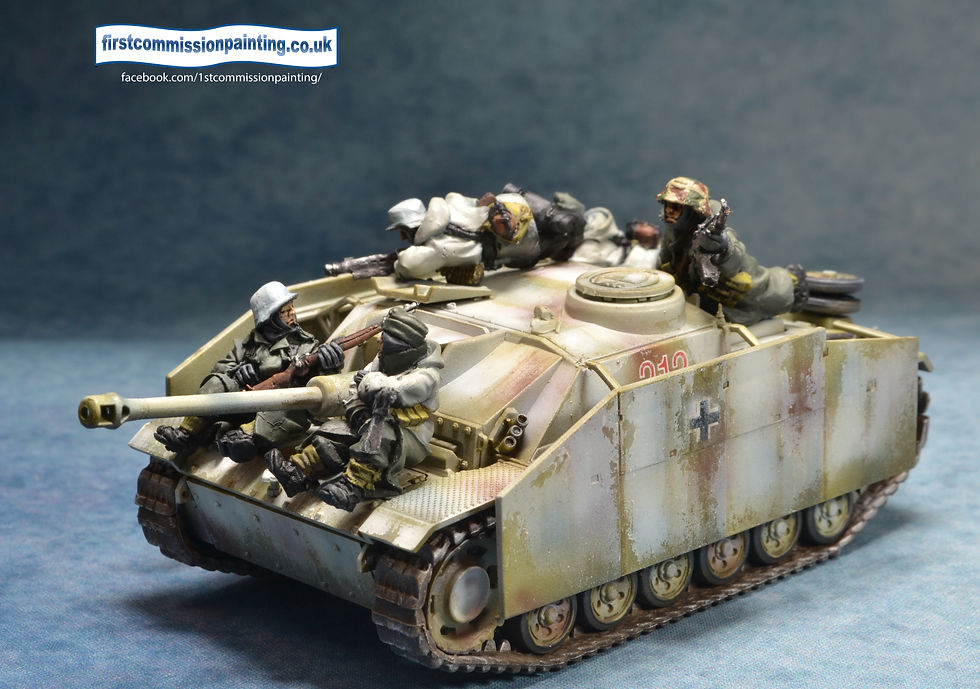Winter Kriegsfuhrung
- johnjsalango1
- Apr 17, 2021
- 4 min read
Updated: May 13, 2022
As everybody knows Germany invaded the USSR on 21st June 1942 in Operation Barbarossa and was spectacularly successful in terms of enemy killed/captured/acreage but fell short before Moscow and Leningrad due to some combination of starting late due to the Balkan Campaign or early autumn mud "glueing" German units in place. From here the story goes that thanks to Hitler believing it would all be over by Christmas after the whole rotten communist edifice collapsed there was no need to issue troops with winter uniforms.

This blog will touch on some of these 'facts' in passing but the real focus is on what happened next as the German troops froze in the Soviet winter of 1941, and 1942, and 1943... How did the German military adapt to the extreme cold encountered in providing uniforms for their men?
Short answer would seem to be that in the winter of 1941 they really didn't and the troops were left largely to cope on their own by improvising. Having passed the culminating point when troops could be efficiently resupplied combined with the conditions of the Ostfront in winter to leave soldiers short of both winter clothing (where it existed in remote supply dumps in the reich) and food as POL and ammunition took priority in the supply chain. As a result "the Germans were sorely outmatched by -40°C Celsius cold, unrelenting snow, icy mud and constant hunger. By December of 1941, there were 130,000 reported cases of frostbite and 15,000 resulting amputations among German soldiers along the Eastern front." In addition the outlook for wounded men in extreme cold and for those on less calories than normal were bleak.
Greatcoats seem to have been the main defence with clothing and boots salvaged from Soviet corpses wherever possible. This lead to a very ragtag look as survival won out over uniformity as can be seen in this mortar crew with one figure wearing stolen Russian overboots. I used a variety of colours for greatcoats from dark grey through dark green to field grey. As usual by mid war there was no consistency from new and after a few months wear basically anything goes.


Sheets were used as improvised winter camo and many helmets and vehicles were whitewashed but hard lessons were learned.
By the next winter spent in Russia which is best known for the Stalingrad campaign the Germans were better prepared and in addition to the greatcoat seem to have issued both a fur lined overcoat to be worn over the greatcoat, a sort of great greatcoat and a proper white smock which went over this. This must have been cumbersome at best but better than dying so there is that.

In these pictures you get a picture of the mix and match kind of approach with issued helmet covers and painted helmets, greatcoats and overcoats plus smocks.

My method of painting white is directly copied from Angel Giraldez and i demonstrate it here https://www.firstcommissionpainting.co.uk/single-post/2019/11/14/winter-camo-t34
except being snow there is a top highlight of actual white.

The officer here seems to be wearing some sort of fur lined leather coat, i dont know if this was an official issue or whether a private item. The man on the laft seems to be wearing the ultimate German winter gera which was the reversible combat suit padded and white on one side and with standard splittermuster camo on the other for the army. These plastic 1/72nd scale minis from Caeser are modelling this gear.


There are lots of photographs of this combat suit in use from 1943 onwards but the existing overcoats/smocks seem to have been more numerous and continue to be worn until the end. Tank crews also needing winter gear as I imagine its no warmer in a steel box than outside of it when its -40 degrees.


Artillery crews would be similarly equipped and would like the panzers whitewash their guns to provide elementary snow camouflage. I imagine this would be a greater priority for Anti Tank and Infantry guns than Field Artillery but there are plenty of pictures of 10.5cm and 15cm guns similarly whitewashed.



So I also whitewashed these over the 1943 Dunkelgelb camo rather than the earlier dark grey of 1941 and '42.


This little Kettenkrad was also snow camouflaged. These are one of my favourite vehicles of WW2, apparently 8000 ish were made and i would buy one if they were still in production.

In the same way this late war Stug IIIg was whitewashed over a fairly generic 1944 camo scheme. The method for doing this is described in a different blog here https://www.firstcommissionpainting.co.uk/single-post/2019/11/14/winter-camo-t34

Cunningly this Stug is also magnetised internally using big magnets to hold on the Begleit riders. I believe these were inspired by Soviet Desantniki tank riders but these were to give assault guns close protection from infantry attacks. The riders have small magnets drilled into them and attach ONLY in this formation.


As an aside all the snow used here was from GW and is easily the best I have used. Other snow is too granular and Bicarb has its own problems. Here I standard based all the figures then pva glued snow. Once it was dry i put another layer of thinned pva and snow. I like it and will use GW snow for everything in future.



Comments